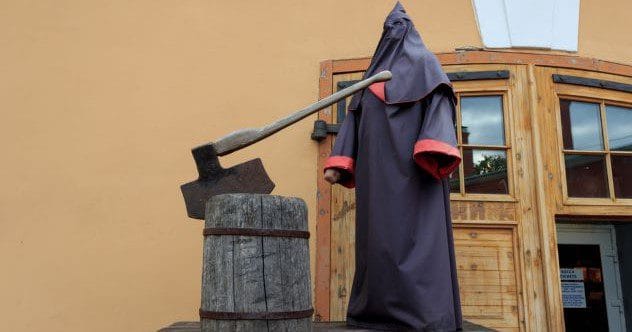In medieval Europe, the executioner’s role was vital, albeit often despised. Tasked with carrying out court sentences, frequently involving gruesome deaths, they maintained law and order by instilling fear. These figures, shrouded in infamy, significantly shaped their societies.
Here, we explore 10 of history’s most notorious executioners, from England’s Pierrepoint family, who executed over 600 people across three generations, to the brutal Spanish Inquisition executioners. Examining their methods and societal context reveals their crucial role in shaping medieval society.
William Calcraft
William Calcraft, an English executioner from 1829 to 1879, was notorious for his cruelty and incompetence. Born into poverty in Essex in 1800, he held various jobs before becoming an executioner. Despite his botched executions and controversial reputation, he served for fifty years, carrying out 430 to 450 executions.
Calcraft, known for his love of spectacle, often made executions as gruesome as possible, employing hanging, beheading, and burning at the stake. However, his hangings were poorly executed, causing prolonged suffering. For instance, the hanging of John Babbacombe Lee took almost an hour. Similarly, his beheadings used a blunt axe, leading to slow, painful deaths. His burnings were equally gruesome, often resulting in death by smoke inhalation rather than flames.
Giovanni Battista Bugatti
Giovanni Battista Bugatti, or Mastro Titta, served as the Papal States’ executioner from 1796 to 1864. Born in Senigallia in 1779, he executed 514 people. His nickname, Mastro Titta, meant Master of Justice in Roman dialect. At 85, Pope Pius IX retired him with a monthly pension.
Bugatti’s preferred methods were beheading, hanging, and breaking on the wheel—a gruesome practice involving beating the condemned with iron bars until their bones broke. Despite his grim profession, Bugatti was known for his professionalism and precision, earning respect from some.
Sanson Family
The Sanson family, a French dynasty of executioners, spanned six generations from the 17th to the 19th centuries. Charles Sanson became the Executioner of Paris in 1684, a position his descendants held for generations. The Sansons were infamous for their role in the death penalty, synonymous with brutality.
The Sansons primarily used beheading, then considered a more humane method. Their skill and efficiency in beheadings made them notorious. Notable executions included Louis XVI, Marie Antoinette, and the highwayman Cartouche. The Sansons’ legacy remains one of history’s most feared executioner families.
Franz Schmidt
Franz Schmidt, an Austrian executioner from 1555 to 1634, served Nuremberg for over 40 years. Born into an executioner family, he continued the legacy, practicing various execution methods. He also interrogated and tortured prisoners. Schmidt kept a detailed journal, providing insights into medieval execution practices.
Schmidt’s expertise included hanging, beheading, and breaking on the wheel. Known for meticulous preparation, he ensured executions were efficient and minimized suffering. Despite the gruesome nature of his work, Schmidt was known for his professionalism and compassion.
Lady Betty
Lady Betty, born around 1740, was a cruel and fearful public executioner. According to Sir William Wilde (Oscar Wilde’s father), she drew portraits of her victims on her dwelling’s walls with a burned stick.
Though partly legend, Wilde’s story lends credence. Elizabeth Sugrue, a poor widow from Kerry, Ireland, was left alone after her children’s departure. One night, she killed a wealthy stranger seeking refuge, only to discover he was her son.
Arrested and sentenced to hang, Betty offered to execute the other prisoners to spare her life. Demonstrating her ability, she became the hangwoman, serving for years, even receiving a pardon in 1802, until her death in 1807.
Jack Ketch
Jack Ketch, or John Ketch, was a controversial 17th-century English figure infamous for brutal, botched executions. Appointed hangman in London in 1663, he became King Charles II’s executioner until his death in 1686.
Ketch used hanging, beheading, and drawing and quartering but was known for inefficiency, earning a reputation as barbaric. His execution of William, Lord Russell, was particularly infamous, involving multiple blows to sever the head, causing a prolonged, agonizing death. This tarnished his reputation, making him a subject of public scorn.
Pierrepoint Family
The Pierrepoint family is renowned for their involvement in 20th-century English executions. Henry Albert Pierrepoint led the family, serving as the British government’s hangman from 1901 to 1910. His brother, Thomas, took over from 1910 to 1946, continuing the family’s service.
The Pierrepoints were known for their skill in hanging, executing high-profile criminals like Ruth Ellis and William Joyce (Lord Haw-Haw). Their legacy, though controversial, remains a significant part of British history.
Bertrand Barere de Vieuzac

Bertrand Barere de Vieuzac, a French revolutionary, served on the Committee of Public Safety during the Jacobin dictatorship of 1793-94. Born in Tarbes in 1755, he became involved in politics and voted for Louis XVI’s execution. His stringent policies made him one of the most feared revolutionaries.
Barere oversaw the guillotine’s use and authorized other execution methods. He reportedly enjoyed watching executions. Despite his controversial legacy, Barere avoided punishment and lived in obscurity until his death in 1841.
Johann Reichhart
Johann Reichhart, a Bavarian executioner in the 20th century, was born in Wurzburg in 1893. Coming from an executioner family, he became Bavaria’s executioner in 1924, serving until 1946. He carried out hundreds of executions, including Nazi war criminals, and trained other executioners.
Reichhart preferred beheading with a guillotine, considering it more humane. Highly skilled, he ensured a quick, relatively painless death. His efficiency earned him a reputation as one of Germany’s best executioners.
Vlad the Impaler
Vlad III Draculea, or Vlad the Impaler, was a Wallachian prince known for his cruel punishments, especially impalement, between 1448 and 1476. His father’s assassination led to his exile, instilling a deep hatred and desire for brutal retribution.
Vlad’s preferred method was impalement, causing a slow, agonizing death, which he considered fitting for his enemies. He impaled thousands, including Turkish soldiers. One account describes a forest of impaled bodies outside a conquered city to deter rebellion.
From William Calcraft’s gruesome spectacles to Vlad the Impaler’s horrifying methods, these executioners left indelible marks on history. Their stories, though disturbing, provide insight into the darker aspects of justice and power.
Which of these figures surprised you the most? Leave your comment below!










